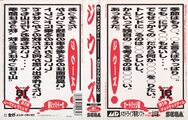Difference between revisions of "The Ooze"
From Sega Retro
Scarred Sun (talk | contribs) |
|||
| Line 78: | Line 78: | ||
| cover=Theooze md jp cover.jpg | | cover=Theooze md jp cover.jpg | ||
| cart=Theooze md jp cart.jpg | | cart=Theooze md jp cart.jpg | ||
| − | + | | manual=Ooze md jp manual.pdf | |
| − | | | + | | item1=Theoozemd jp innercover.jpg |
| − | + | | item1name=Inner Cover | |
| − | | | ||
| − | | | ||
}}{{Scanbox | }}{{Scanbox | ||
| console=Mega Drive | | console=Mega Drive | ||
Revision as of 16:36, 2 June 2013
| The Ooze | |||||
|---|---|---|---|---|---|
| System(s): Sega Mega Drive | |||||
| Publisher: Sega | |||||
| Developer: Sega Technical Institute | |||||
| Sound driver: GEMS | |||||
| Genre: Action | |||||
| |||||
The Ooze (ジ・ウーズ) is a Sega Mega Drive/Genesis game created by STI in 1995.
The Ooze is based on an algorithmically-generated cellular automaton. As such, the main character can be split apart and reformed like a viscous liquid. The gameplay is reminiscent of The Bitmap Brothers' game The Chaos Engine (called Soldiers of Fortune in the US). The art style evokes a cartoony (necessitated by the constraints of the medium) H.R. Giger. The story recalls The Toxic Avenger. The development team included people who later worked for Blizzard North on Diablo and Diablo II, including designer Stieg Hedlund. Some of the programming was fairly advanced for a 16-bit system; for example, the speed powerup effect was actually created by decreasing the viscosity of the character.
The game takes place from an overhead view. The main character is a puddle of ooze with a head. He can move around and has two attacks. One is stretching out a steerable pseudopod of ooze whose length is only limited by how much ooze he currently has to attack (![]() ), and it can also be guided around with the control pad. He can also spit gobs of ooze (
), and it can also be guided around with the control pad. He can also spit gobs of ooze (![]() ), although this takes off a bit of his puddle. Enemy attacks can cut off a bit of the ooze, and the player will die either if his puddle of ooze is reduced to a very small amount or if his head is attacked directly.
), although this takes off a bit of his puddle. Enemy attacks can cut off a bit of the ooze, and the player will die either if his puddle of ooze is reduced to a very small amount or if his head is attacked directly.
The game's status as a cult classic is confirmed by its inclusion in the Japanese version of Sonic Mega Collection and in all versions of Sonic Mega Collection Plus. It is unlockable in two ways: In the Xbox and PlayStation 2 version, it can be unlocked if you have a Sonic Heroes save. In all versions, it can be unlocked by playing any game on the disk for 30 hours.
Production Credits
- Producer: Michael Wallis
- Concept & Lead Programmer: Dave Sanner
- Art Directors: Robert Steele, John Duggan
- Artists: Alan Ackerman, Stieg Hedlund, Dean Ruggles, Joe Stephenson, Craig Stitt, Tom Tobey, Marte Thompson
- Design: Jason Kuo, Stieg Hedlund, Dave Sanner
- Intro & Ending Artwork: Tony De Zuniga, Tom Tobey
- Music & Sound Effects: Howard Drossin
- Boss Programming: Robert Morgan
- Lead Tester: Rey Alferez
- Testers: Timothy Spengler, Todd Slepian, Mike Benton, Nelson Chiu, Alfred Dutton, Steve Fallas, Richie Hideshima, Michael Ironside, Dylan Manger, David Paniagua, Sean Potter, Jeff Sanders, Stan Weaver, Michael Wu
- Programming & Technical Thanks: Scott Chandler, Jason Plumb, Mark Cerny
- Special Thanks: Roger Hector, Sheri Hockaday, Emi Kawamura, Sue Ortlip, Paul Sears, Dean Lester, Michael Kosaka, Hoyt Ng
- Created by: Sega Technical Institute
- Presented By: Sega & Sega of America
Manuals
Physical Scans
| Sega Retro Average | |||||||||||||||||||||||||||||||||||||||||||||||||||||||||||||||||||||||||||||||||||||||||
|---|---|---|---|---|---|---|---|---|---|---|---|---|---|---|---|---|---|---|---|---|---|---|---|---|---|---|---|---|---|---|---|---|---|---|---|---|---|---|---|---|---|---|---|---|---|---|---|---|---|---|---|---|---|---|---|---|---|---|---|---|---|---|---|---|---|---|---|---|---|---|---|---|---|---|---|---|---|---|---|---|---|---|---|---|---|---|---|---|---|
|
| 69 | |
|---|---|
| Based on 17 reviews | |
| Mega Drive, JP |
|---|
| Mega Drive, AU |
|---|
|
| Mega Drive, BR |
|---|
|
- ↑ 1700 igr dlya Sega, "" (RU; 2001-xx-xx), page 156
- ↑ Electronic Gaming Monthly, "September 1995" (US; 1995-0x-xx), page 35
- ↑ Game Players, "Vol. 8 No. 10 October 1995" (US; 1995-xx-xx), page 46
- ↑ GamePro, "November 1995" (US; 1995-xx-xx), page 80
- ↑ Game Informer, "September 1995" (US; 1995-0x-xx), page 55
- ↑ Joypad, "Mars 1996" (FR; 1996-0x-xx), page 43
- ↑ Mega Force, "Mars 1996" (FR; 1996-0x-xx), page 72
- ↑ Mean Machines Sega, "January 1996" (UK; 1995-11-xx), page 67
- ↑ Next Generation, "October 1995" (US; 1995-09-19), page 125
- ↑ Player One, "Mars 1996" (FR; 1996-0x-xx), page 100
- ↑ Power Up!, "Saturday, February 17, 1996" (UK; 1996-02-17), page 1
- ↑ Saturn Fan, "1995 December" (JP; 1995-11-08), page 70
- ↑ Sega Pro, "January 1996" (UK; 1995-11-30), page 29
- ↑ Sonic the Comic, "24 May 1996" (UK; 1996-05-11), page 17
- ↑ Tricks, "Vypusk 8" (RU; 1996-xx-xx), page 27
- ↑ Tricks 16 bit, "Tricks Sega Gold 800 igr" (RU; 1998-03-20), page 130
- ↑ VideoGames, "October 1995" (US; 1995-09-19), page 80
- Pages with broken file links
- No players field
- Old content rating field
- Use romtable template
- All games
- Old-style rating (egm)
- Rating without source
- Old-style rating (gameplayers)
- Old-style rating (joypad)
- Old-style rating (mms)
- Rating without PDF source
- Old-style rating (playerone)
- Old-style rating (segapro)
- Update ratings template
- 6 old ratings
- Sega Channel games



